#difference between nodejs and python
Explore tagged Tumblr posts
Text
Choosing between Node.js and Python for backend development? This article explores the key differences in Node.js vs Python performance, scalability, and ease of development. Learn about the difference between Python and JavaScript and whether Node.js development services offer a faster alternative. Find out is Node.js faster than Python and which technology suits your project best.
#node js vs python#node js and python#is nodejs faster than python#node js development services#difference between python and javascript#node js vs python performance#python vs javascript web development
1 note
·
View note
Text
System Shock 2 in Unreal Engine 5
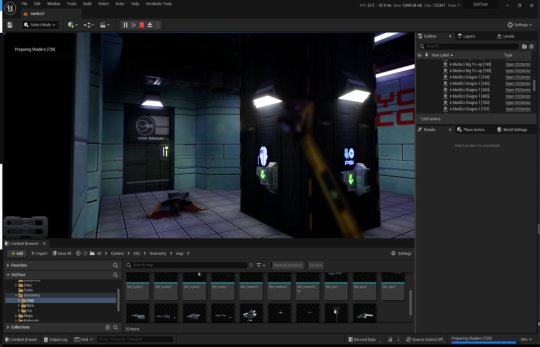
Tools, tools, tools
Back when I worked in the games industry, I was a tools guy by trade. It was a bit of a mix between developing APIs and toolkits for other developers, designing database frontends and automated scripts to visualise memory usage in a game's world, or reverse engineering obscure file formats to create time-saving gadgets for art creation.
I still tend to do a lot of that now in my spare time to relax and unwind, whether it's figuring out the binary data and protocols that makes up the art and assets from my favourite games, or recreating systems and solutions for the satisfaction of figuring it all out.
A Shock to the System
A while back I spent a week or so writing importer tools, logic systems and some basic functionality to recreate System Shock 2 in Unreal Engine 5. It got to the stage where importing the data from the game was a one-click process - I clicked import and could literally run around the game in UE5 within seconds, story-missions and ship systems all working.
Most of Dark engine's logic is supported but I haven't had the time to implement AI or enemies yet. Quite a bit of 3D art is still a bit sketchy, too. The craziest thing to me is that there are no light entities or baked lightmaps placed in the levels. All the illumination you can feast your eyes on is Lumen's indirect lighting from the emissive textures I'd dropped into the game. It has been a fun little exercise in getting me back into Unreal Engine development and I've learnt a lot of stuff as usual.
Here is a video of me playing all the way up to the ops deck (and then getting lost before I decided to cut the video short - it's actually possible to all the way through the game now). Lots of spoilers in this video, obviously, for those that haven't played the game.
youtube
What it is
At it's core, it's just a recreation of the various logic-subsystems in System Shock 2 and an assortment of art that has been crudely bashed into Unreal Engine 5. Pretty much all the textures, materials, meshes and maps are converted over and most of the work remaining is just tying them together with bits of C++ string. I hope you also appreciate that I sprinkled on some motion-blur and depth of field to enhance the gameplay a little. Just kidding - I just didn't get around to turning that off in the prefab Unreal Engine template I regularly use.
Tool-wise, it's a mishmash of different things working together:
There's an asset converter that organises the art into an Unreal-Engine-compatible pipeline. It's a mix of Python scripting, mind numbingly dull NodeJS and 3dsmaxscript that juggles data. It recreates all the animated (and inanimate) textures as Unreal materials, meshifies and models the map of the ship, and processes the objects and items into file formats that can be read by the engine.
A DB to Unreal converter takes in DarkDBs and spits out JSON that Unreal Engine and my other tools can understand and then brings it into the Engine. This is the secret sauce that takes all the levels and logic from the original game and recreates it in the Unreal-Dark-hybrid-of-an-engine. It places the logical boundaries for rooms and traps, lays down all the objects (and sets their properties) and keys in those parameters to materialise the missions and set up the story gameplay.
Another tool also weeds through the JSON thats been spat out previously and weaves it into complex databases in Unreal Engine. This arranges all the audio logs, mission texts and more into organised collections that can be referenced and relayed through the UI.
The last part is the Unreal Engine integration. This is the actual recreation of much of the Dark Engine in UE, ranging all the way from the PDA that powers the player's journey through the game, to the traps, buttons and systems that bring the Von Braun to life. It has save-game systems to store the state of objects, inventories and all your stats, levels and progress. This is all C++ and is built in a (hopefully) modular way that I can build on easily should the project progress.
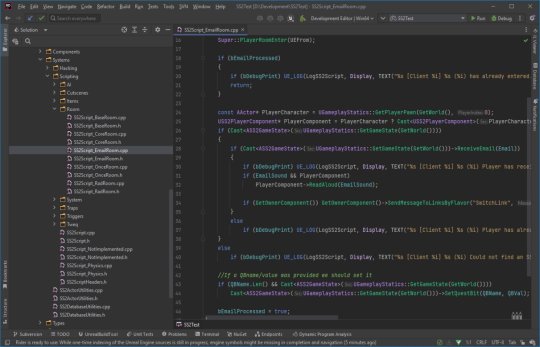
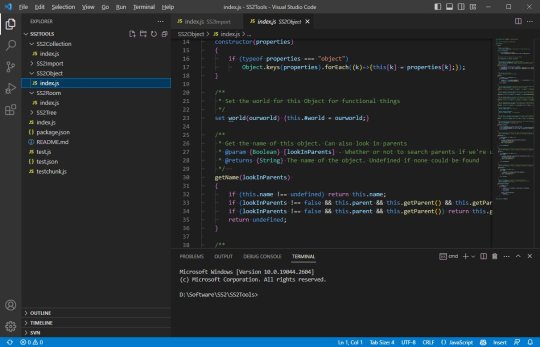

Where it's at
As I mentioned, the levels themselves are a one-click import process. Most of Dark engine's logic, quirks and all, is implemented now (level persistence and transitions, links, traps, triggers, questvars, stats and levelling, inventory, signals/responses, PDA, hacking, etc.) but I still haven't got around to any kid of AI yet. I haven't bought much in the way of animation in from the original game yet, either, as I need to work out the best way to do it. I need to pull together the separate systems and fix little bugs here and there and iron it out with a little testing at some point.
Lighting-wise, this is all just Lumen and emissive textures. I don't think it'll ever not impress me how big of a step forward this is in terms of realistic lighting. No baking of lightmaps, no manually placing lighting. It's all just emissive materials, global/indirect illumination and bounce lighting. It gets a little overly dark here and there (a mixture of emissive textures not quite capturing the original baked lighting, and a limitation in Lumen right now for cached surfaces on complex meshes, aka the level) so could probably benefit with a manual pass at some point, but 'ain't nobody got time for that for a spare-time project.
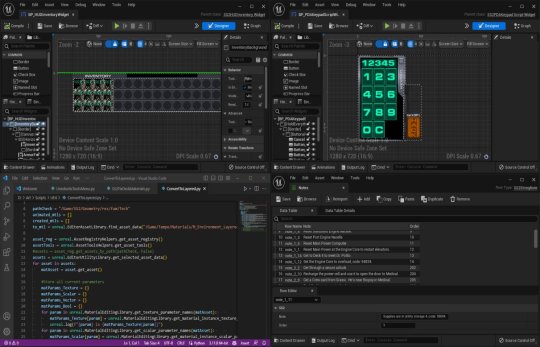
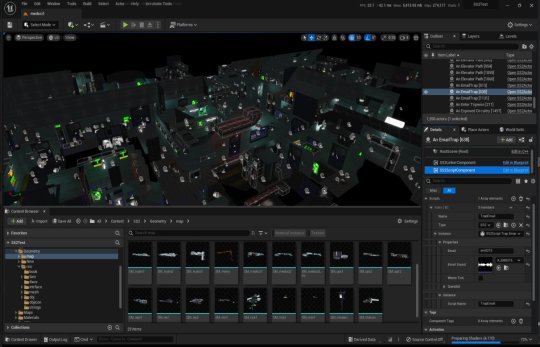
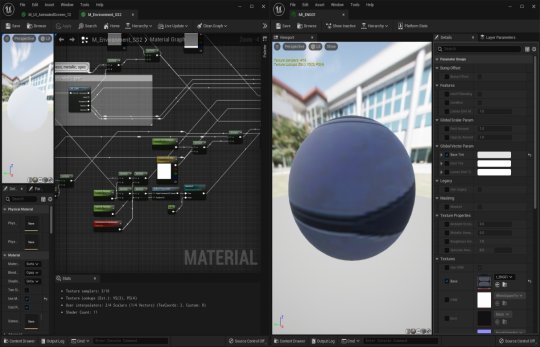

The unreal editor showcasing some of the systems and levels.
Where it's going
I kind of need to figure out exactly what I'm doing with this project and where to stop. My initial goal was just to have an explorable version of the Von Braun in Unreal Engine 5 to sharpen my game dev skills and stop them from going rusty, but it's gotten a bit further than that now. I'm also thinking of doing something much more in-depth video/blog-wise in some way - let me know in the comments if that's something you'd be interested in and what kind of stuff you'd want to see/hear about.
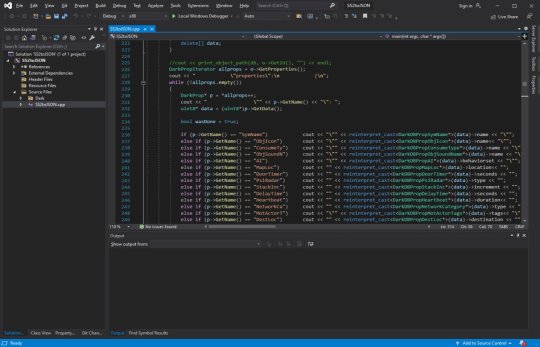
The DB to JSON tool that churns out System Shock 2 game data as readable info
Anyway - I began to expand out with the project and recreate assets and art to integrate into Unreal Engine 5. I'll add more as I get more written up.
#game development#development#programming#video game art#3ds max#retro gaming#unreal engine#ue5#indiedev#unreal engine 5#unreal editor#system shock 2#system shock#dark engine#remake#conversion#visual code#c++#json#javascript#nodejs#tools#game tools#Youtube
1 note
·
View note
Text
Which full stack is demand?
Which full stack is demand?
In the world of web development, there's a term you might hear a lot: full-stack developer. However, one may be wondering, except what, and why do these people make such high demand?

Definition of Full Stack Development
For example, the internet could be a website or web app. It has two main parts: the front-end, as in the functionality that users see and interact with, and the back-end, which refers to the engine that does all the work in the background. With the help of a full-stack developer, you can know both sides of the house. They can design the user interface just as you see it (front end), or they can create the logic that makes things happen (back end), and other tasks required by the app operation.
Why are they so in-demand?
Companies need full-stack developers because they are 2 in 1 developers. They provide end-to-end management, and this results in the saving of time, money, and cost of resources. Here's why they're so valuable:
Versatility:
Full-Stack Developers have the ability to move between design work and programming tasks, thus making the process of project development flow smoothly.
Efficiency:
Full-Stack Developers do not need to pay for the outdated model that consists of these positions neither slowing down the development process.
Big Picture Thinking:
They are aware of the interdependence of the various parts, and as a result, they design solid and functioning apps.
The Skills Stack
To become a full stack developer, you'll need to master a range of skills, including:
Front-end: HTML, CSS, JavaScript (the frameworks would be React or Angular).
Back-end: Programming languages like Python, Java or Ruby, databases and interactive systems at the server level.
Bonus points: - Version control systems (like git) and learning about APIs (which enables different applications to communicate with each other - them being connected).
If you are a coder, problem solver and you take pleasure in bringing your ideas into existence, then a full stack development could be exactly what you need. This field is for people who want to accept challenges with pleasure and there are plenty of career moves. As more and more leaders are needed in the workplace and the salaries being paid are also very attractive, it is…promising ndeas to explore this field.
Pune is home to many multinational companies and ever-evolving technology and in this tech hub city demand for certified skilled Full-Stack Developers is touching skies. Making Pune a rightful place to start Full-Stack Development career and Full-Stack Developer Course in Pune is best for you to kick-start your career.
At our best Full-Stack Developer Training in Pune, the courses are carefully forged to meet the latest industry trends and technologies, from front-end essentials- HTML,CSS and JavaScript to back-end framework React, Angular and NodeJS and more. The Full-Stack Developer course in Pune covers all the latest trends and technology. Students are also encouraged to engage in live projects and group projects for them to gain hands-on experience.
We believe that just theoretical knowledge is not enough for someone to have a successful career. Inorder to live a successful career one needs to a practical knowledge too and at Best Full-Stack Developer course in Pune, we understand that and provide our students with real-world project experience, we encourage our student to create at least 3 to 5 projects and also indulge in live-projects. This will increase their practical knowledge and will build a strong portfolio for their future.
At our Full-Stack Developer Training in Pune, We understand the need of being employed in this fast paced digital era. We provide our students with career guidance by conducting soft skill classes, mock interviews, workshops where they learn how to create portfolio and resume, and special lectures with professional Developers in the Industry. At Full-Stack Developer classes in Pune, We assure our students with 100% Placement Guarantee. We are committed to providing all the necessary skills for them to kick start their career. We prepare our students to face the interviews with grace and confidence.
Join our Course Now!
#full stack training in pune#full stack developer classes in pune#best full stack developer course in pune#full stack developer course in pune#full stack courses in pune#full stack classes in pune#full stack developers in pune#full stack developer#full stack training
0 notes
Text
Why Full Stack Java Developers Are More Preferred Over Mean Stack Developers?
Full stack java developers are undoubtedly preferred over MEAN stack developers because of several factors and features that make full stack Java development an attractive choice for professionals seeking a well-rounded career in software development.
A full stack Java developer possesses skills in both front-end and back-end development using Java technologies. Java is a widely used and versatile programming language known for its stability, scalability, and extensive community support. It enables the development of robust and enterprise-level applications across various domains, including web development, mobile apps, and enterprise software.
Full stack Java developers can leverage the extensive Java ecosystem, gain access to a wide range of libraries and frameworks, and work with established tools and technologies. Java's presence in many enterprise environments makes it a solid choice for developing large-scale applications. Additionally, the demand for skilled Java developers remains high, providing a strong job market for full stack Java development. Here are some key features of full stack Java development that contribute to its popularity:
Versatility and Flexibility: Full stack development offers a broader skill set, allowing developers to work on different aspects of the application stack. With proficiency in both front-end and back-end technologies, full stack developers can handle diverse projects and contribute to various stages of development. This adaptability makes them valuable in the job market.
Wide Adoption of Technologies: Full stack Java developers often work with widely adopted technologies such as Java, Python, or .NET, which have large developer communities and extensive resources available for support and collaboration.
Established Job Market: Full stack Java development has a well-established job market with numerous opportunities across industries. Many large organizations rely on full stack Java developers to handle complex projects and maintain their software systems. This stability and demand provide a sense of job security and opportunities for career growth.
Seamless Integration with Existing Systems: Full stack development allows for seamless integration with legacy systems and the ability to leverage existing infrastructure. Full stack Java developers can bridge the gap between different components, ensuring smooth transitions and efficient operations.
Diverse Project Scope: Full stack Java developers have the advantage of working on a wide range of projects, including web development, mobile apps, database design, and server management. This variety keeps the work interesting and provides opportunities for continuous learning.
Continuous learning is crucial for full stack Java developers to stay updated with evolving technologies and frameworks. This ongoing learning process helps them remain adaptable and capable of taking on new challenges. If you're interested in pursuing a career as a full stack Java developer, it's important to upskill yourself and enroll in a reputable full stack Java developer course. FutureSkills Prime, a joint initiative of the Government of India and nasscom, offers industry-aligned and government-approved courses in the web development field such as java full stack course, full stack data science course, full stack java developer course, etc. Here are some courses available on FutureSkills Prime to help you start your journey:
Full Stack Web Development Using Python
Full Stack development
Learning Path in Full Stack Development
Full Stack Web Development Hybrid Training Program
Full Stack Web Development MERN Development
Full Stack Java Developer Program
Foundation Full Stack Web Development with NodeJS
Professional Full Stack Web Development: HTML, CSS, JS, ReactJS
These courses will equip you with the necessary skills and knowledge to excel as a full stack Java developer. Good luck with your journey!
0 notes
Link
If you are looking for the difference between node.js vs. python then you can check out this blog on the differences between the node and python, and which is a better option for backend development.
0 notes
Link
Best Software Training institutes in Pune
UNIQUE System Skills LLC is the best Software Training institute in Pune, Maharashtra which is incorporated in the year 2008, Since then we have provided our technical services to several Fortune 500 companies worldwide with a presence in India & USA. Our company is committed to maintaining a culture of integrity, diversity, and ethics throughout the organization and its associated partners. UNIQUE System Skills LLC is a global IT Recruiting, Training, and Consulting Company that provides excellent services to its clients and customers for their staffing and training needs.
After successfully commencing the business with a corporate office in Nashua, New Hampshire, we started the development center/BPO in India as Unique System Skills (India) Pvt. Ltd. We are proud to take the role of a young, dynamic, and high-level executive recruitment consultant that is committed to superior quality performance with a high rate of placements all around the GLOBE.
We have a well-established track record and our services have always met with great customer satisfaction. We offer high-quality services at a very competitive price. Our Expertise helps organizations to find the best talent within the budget and given timeframe.
UNIQUE System Skills LLC understands and believes that recruiting and hiring the right people to join your team can be the difference between success and failure so it is very important to get the right pool of candidates but sometimes we may find it challenging. UNIQUE System Skills LLC is a team of dedicated experts who have closed 1500+ positions on multiple domains and IT skills. UNIQUE System Skills LLC provides a wide range of staffing solutions only dedicated to IT, BFSI, Non-IT, Manufacturing, Service & ITES industries. UNIQUE System Skills LLC follows a well-defined process methodology with strong delivery support.
UNIQUE System Skills LLC has highly trained and well-experienced IT recruiters who drive the process of sourcing till hiring closure based on client needs. Using various innovative tools and analytical approaches UNIQUE System Skills LLC has designed unique solutions to deliver large-scale and critical recruiting projects for clients. UNIQUE System Skills Provide Training in C, C++, Core Java, Advance Java, Spring/Hibernate/Struts Framework, Angular js, Nodejs, Python, MongoDB, Full Stack Developer Training, Andriod, PHP, Laravel, Codeignitor, Asp.net with C# MVC, Manual Testing + Automation Testing (Selenium) with Quality Live Project Training & 100% Satisfaction Guaranteed. That’s the main reason USS is the best software training center in Pune.
The training division of USS is also experiencing great success, with training facilities operating in India and the U.S. we have trained over 1000+ students in the IT field. Over the past years, USS has been recognized for several achievements. We were awarded the excellence award in 2016 by USPAAC as one of the Fast 100 Asian American Businesses in the U.S. We have also been awarded as winners at the 2016 ICIC 100 fastest-growing inner-city companies with an average growth rate of 875.18% coming in spot 12 from a list of over 850 companies nationwide in the USA. We are a proud INC 5000 and ISI 9001-2015 recognized company that continues to work hard to exceed quality expectations on GLOBAL STANDARDS LEVELS
2 notes
·
View notes
Text
Is Node.js Killing Python and PHP?
PHP, Python, and Node.js are three of the most widely used technologies supporting the backend of web applications. Python is the oldest of these three, having debuted in 1991, whereas PHP has ruled the market for more than 20 years. On the other hand, Node.js, which was introduced in 2009 despite being a relative newcomer, is quickly moving to the top of the list of developers' preferred technologies.
What is Node.js?
An open-source server-side JavaScript code execution platform is Node. js. The vast array of JavaScript modules it offers facilitates the creation of web applications.
What is Python?
Python is a multipurpose, object-oriented programming language that's frequently employed to create software and websites, analyze data, and automate processes. It is not therefore limited to server programming and the backend web.
What is PHP?
One of the most popular server-side programming languages and the most popular Node.js substitute is PHP. Personal Home Page was the original meaning of the language's name. Eventually, a recursive acronym for PHP: Hypertext Preprocessor was created.
What are the key differences between Nodejs, Python, and PHP?
1. Use Cases
2. Architecture
3. Database Support
Because Additionally, all three technologies are open source and are frequently combined to create the same online applications, this is an in-depth article that will help you in getting complete information related to using Node.js Killing Python, and PHP.
0 notes
Text
I used Kinoite, but I feel it's pretty barebones - I switched to a downstream of it (Aurora from the Universal Blue project) relatively soon.
That's honestly the best part - switching distros/flavors (at least between Fedora and UBlue) is as easy as updating, pretty much. (As long as you've got everything in containers, and not layering). I haven't had to rollback yet, but I assume it's the same. It does feel impossible to break the base distro.
But that's maybe also the big catch - you can't break what you can't customize. Everything is in Podman now. (Some stuff is on Homebrew, on Aurora). So if you're a dev, Podman skills are a must.
I had a comparatively easy time switching, as I had set up a lot of dev envs in containers already bcs people at work wanted to use old versions of PHP - but if you haven't used containers yet, and need something like that, you might have a harder time.
Something like Python might possible to set up outside of docker with pyenv, or Nodejs with nvm - but if you compile stuff from source, and need headers or specific deps, you pretty much need a container.
So yeah, I'd say if your podman/kubernetes-Fu is up to speed, I'd recommend it. If not, I'd start to work on that first, because immutable distros really enforce that discipline afterwards, for better or worse.
As for Flatpak: It's fine. It works. No noticable difference, imo.
have any of you nerds tried Kinoite? (or silverblue) i want to switch to an immutable distro and i'm too cool to use nixos
57 notes
·
View notes
Photo
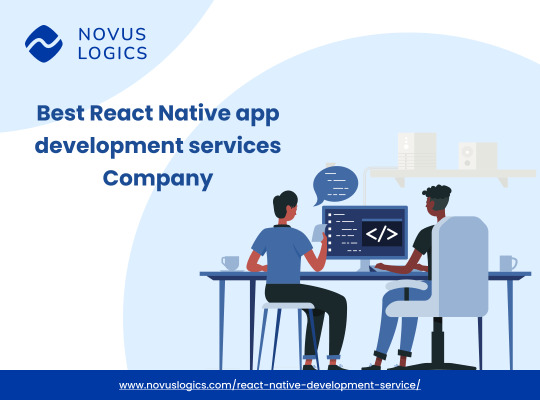
Whether you are looking to build standalone, client-server, web service driven or database driven mobile apps, our experienced and skilled React Native app developers can help you achieve an React Native app development that meets your enterprise needs and requirements.
Our React Native app developers have strong skills in developing native apps using C++ and JavaScript. Our app developers are also experienced in cross-platform development and migrating other existing mobile apps or Java-based apps to different platforms. React Native app development services include design, development and enhancement of mobile software that runs on all supported different OS versions. By targeting React native, hybrid and cross-platform development, Novus Logics always ensures a sustainable and seamless mobile experience.
Along with the R&D department, we at Novus Logics keep up with trends in video data processing, object tracking, geographic information systems, digital signal processing in devices and more, to offer React Native apps that stand out from the crowd. We strike a balance between your business goals and user needs to develop customer-centric React Native apps that help drive incremental revenue. #reactnativeappdevelopment #reactnativeappdevelopmentservices #novuslogics#reactnative #javascript #reactjs #html #programming #react #css #python #coding #android #developer #java #webdevelopment #programmer #flutter #webdeveloper #nodejs #php #softwaredeveloper #angular #appdevelopment #ios #vuejs #software #typescript #js #mobiledevelopment #mongodb #coder #javascriptdeveloper #electionresults2023 #RiseOfNTK #railway_level1_waiting_do #WomensDay
0 notes
Text
Comparison Guide: Software Developers Hourly Rates by Top Regions Worldwide
Today’s IT marketplace gives businesses the flexibility to outsource software development services to an overseas team. Offshoring opens new opportunities to select from a global talent pool while saving costs. However, the hourly rates for hiring a software developer vary greatly from country to country across different continents.
Here we have put together relevant facts and data to help businesses make a confident choice.
Current State of Outsourcing Software Development Worldwide
The outsourcing industry came into being in the early 2000s and has since grown exponentially transforming different sectors. Let’s look at some latest trends that show the current state of offshoring software development.
The value of the IT outsourcing market stood at USD 526.6 billion in 2021 and is expected to touch USD 682.3 billion by 2027, growing at a rate of about 4.13% a year.
The business process outsourcing market is forecasted to grow by a CAGR (Compound Annual Growth Rate) of over 7% a year reaching USD 76.90 billion during the forecast period of 2023-2027.
The recent trends show that more and more organizations are partnering with software outsourcing companies to onboard highly skilled professionals. The goal is to enhance core organizational processes, reduce costs, improve service quality, and facilitate transformation.
How Software Development Rates Have Changed over the Previous Years
The market trends have evolved drastically over the past couple of years and so have the software development rates globally.
In fact, there will be a 4% rise in the compensation sought by app developers for their software development services, and it will continue to rise for all technologies. Among these technologies come ReactJS, Python, React Native, NodeJS, Java and PHP.
Global Region-Wise Hourly Rates of Software Development
If you are looking to hire a software development team, this quick snapshot of hourly rates for software developers across the globe will come in handy.
Destination
Outsourcing Rates
Countries Included
Asia
$18 – $40
China, India, Philippines
Latin America
$30 – $50
Chile, Brazil, Argentina, Columbia, Peru, Mexico
North America
$38 – $63
Canada, United States, Mexico
Eastern Europe
$25 – $50
Bulgaria, Romania, Ukraine, Poland, Hungary
Western Europe
$20 – $45
Switzerland, Netherlands, Austria, Belgium, Germany
Africa
$20 – $40
Kenya, Morocco, South Africa, Egypt, Nigeria
Software Development Hourly Rate in the United States
With $38-63 per hour, the U.S. has the highest software development rates in the world. You can expect to pay salaries ranging from between $137k to $173k (inclusive of taxes and benefits).
Despite the high cost, the U.S. software developers are worth considering for the additional skills they bring to the table along with almost no language barrier and complete time zone availability.
City
Average per-hour rate
San Francisco
$62.5
Los Angeles
$52.5
New York
$59
Chicago
$48.7
Software Development Rates in Asian Countries
Asia is home to a huge number of software developers, making it a leading IT outsourcing destination. However, the hourly rates differ drastically from country to country. China, India, and the Philippines are the top three Asian countries offering high-value software and website development services.
In India, you can hire developers starting at about $18 an hour for a junior developer and reaching $40/hr for highly experienced professionals. The country is one of the most preferred outsourcing countries because of its affordability.
The Philippines is touted as the second-best country to put together your external software team. You can hire junior software developers at an hourly rate of:
Manila - $7-$12
Cebu - $9-$13
The third-best country to outsource software development projects to is China. Chinese developers rank 1st in all the HackerRank.com platform challenges, and the country today boasts over 50 science and technology industrial parks.
Countries
Average hourly rates
India
$6.72
Philippines
$5.62
China
$8.52
Software Development Rates in Europe
Europe is known for its qualified IT professionals available at cost-effective rates. For instance, Ukrainian developers are likely to be more budget-friendly in Poland. However, the average hourly salary for junior developers across Europe is $25 – $50 per hour. Belarus, Russia, Poland, The Czech Republic, and Romania are the top European countries to hire offshore development teams.
Western Europe
You can find dedicated offshore developers in Western Europe but the rates will be higher due to the high cost of living and taxation systems. You can expect to pay $20 – $45 per hour, amounting to an annual cost of about $60k.
Eastern Europe
Eastern Europe is a hotbed for start-up businesses. Plus, the market is full of developers skilled in software technologies and programming languages.
You can hire custom software development services in this region at $11-$25 per-hour rate. The average salaries that software developers make range from $40k to $70k (Poland being the most expensive).
In Ukraine, software developers offer their services for an average hourly rate of $26, paying $25 to $50 per hour for a software engineer. The time zones don’t vary much across most Western European countries.
Countries
Average hourly rates
France
$42
Germany
$32
The United Kingdom
$28
Bulgaria
$32
Romania
$35
Software Development Rates in Latin America (Nearshore)
The cost of hiring a software development team in Latin America is higher than the APAC and European regions, but still offers a cost savings over Onshore development costs.
Junior Developer: $25 – $34 per hour
Mid-level Developer: $50 – $80 per hour
Senior Developer: $100 – $120 per hour
Argentina
Since Argentina has its cultural and economic ties to Europe, European trends influence its IT market. The country is the most expensive destination for
hiring offshore development teams as their developers are highly experienced in working with western countries.
Colombia
Colombia’s IT market receives an additional batch of nearly 13,000 software developers every year. Most of these developers join offshore companies. The country benefits from American influence and has CMMI-certified companies.
Brazil
Brazil is often a clear choice for offshoring software and website development services. 8 of the top 10 technology universities are in Rio de Janeiro, and the global IT center is in Brazil. These universities graduate 14 thousand students in a year.
Countries
Average hourly rates
Argentina
$6.49
Colombia
$6.65
Brazil
$7.56
Software Development Rates in Africa
Africa’s IT industry may have just begun to take shape but is growing rapidly. Therefore, the country has gained significant attention in the global IT outsourcing market.
Recent reports predict that Africa’s IT business is expected to reach $180 billion by 2025. The industry will further contribute $712 billion in revenue, contributing 8.5 % of the continent’s Gross Domestic Product (GDP).
Top companies look for talented offshore software engineers (with Python, Ruby, and SQL expertise) in North African countries like Egypt, Morocco, and Tunisia.
South African developers often have high proficiency in English, German, Dutch, and other languages. Also, many developers skilled in C++, PHP, and SQL are available at reasonable hourly rates.
The highest number of software developers is in East Africa’s Kenya. Its capital, Nairobi, has an impressive IT infrastructure to support start-ups for technical innovation. Moreover, the software developers are skilled in SQL, Java, and mobile development.
Countries
Average hourly rates
Egypt
$20
Kenya
$20
Nigeria
$40
Morocco
$40
Tips to Recruiting the Right Offshore Software Developers
When deploying your offshore product development team, recruiting the right software developers is crucial. Managing an outsource team is never similar to managing an in-house team. Here are some areas to consider when selecting your offshore software development services provider.
Create a specific list of your expectations and requirements, like the tech stack they use, personal skills, experience, and knowledge of certain tools/frameworks.
Screen and evaluate potential developers for their core technician skills, like their ability to write codes efficiently in real-time. Check your candidates’ problem-solving approach by giving complex real business cases to solve.
Cultural compatibility can make all the difference, ensuring that their ethics and values align with yours.
Give your potential candidates strong reasons to pick you to work with. This approach will help you attract and retain highly talented professionals.
Engage your potential software developers in two-sided conversations where they feel free to exchange their ideas. This will promote their involvement in the project and make them feel excited to work with you.
Conclusion
More and more businesses today are choosing to outsource custom software development The reason: you gain access to a larger talent pool, a competitive edge, and the skills needed to develop robust digital products at a bargain.
VLink, headquartered in CT, with our other branch office located in Massachusetts and Global tech talent delivery centers in India, Canada and Indonesia is your reliable
offshore software development
company that brings an impressive package of experience, skills, and the ability to innovate and produce according to our clients’ unique ideas and requirements.
Let's connect
to discuss how we can add value to your business as your extended IT team.
0 notes
Photo

Difference between REST and SOAP APIs REST and SOAP are both web service communication protocols, but they have some key differences. REST: 1. REST is a lightweight, resource-based approach to interacting with web services. 2. It's considered more flexible and easier to implement than SOAP. 3. It doesn't impose any kind of security like SOAP. 4. It supports a greater variety of formats like JSON, and multipart/form-data. 5. It requires smaller bandwidth. SOAP: 1. SOAP, on the other hand, is a more formal, message-based protocol that uses only XML for its message format. 2. It also has built-in error handling and is often used in enterprise environments. 3. It requires a large bandwidth #api #restapi #soap #apidevelopmentjavascript #js #angularjs #reactjs #angular #web #webdeveloper #html #css #css3 #html5 #frontend #frontenddeveloper #vuejs #expressjs #nodejs #coder #coding #programmer #programming #software #informationtechnology #java #python #php #frontendjob https://www.instagram.com/p/CnutL1JDHXD/?igshid=NGJjMDIxMWI=
#api#restapi#soap#apidevelopmentjavascript#js#angularjs#reactjs#angular#web#webdeveloper#html#css#css3#html5#frontend#frontenddeveloper#vuejs#expressjs#nodejs#coder#coding#programmer#programming#software#informationtechnology#java#python#php#frontendjob
1 note
·
View note
Text
NodeJs Vs Golang

With regards to web improvement, there are many programming dialects to look over. Two of the most well known decision are NodeJS vs Golang . Things being what they are, which one would it be a good idea for you to use for your next project? Here is a presentation of Go and Hub in 2022 as the two of them are developing backend advancements.
Golang is a strong, statically-composed language that is not difficult to peruse and compose. It is quick and productive, settling on it an incredible decision for enormous tasks.
Then again, Node.js is a runtime that runs JavaScript, that is more flexible language that can be utilized for both front-end and back-end improvement. It is likewise somewhat simple to learn, and an enormous local area of engineers can browse.
Albeit both Golang and NodeJS are profoundly famous among the designer local area, the inquiry is, who wins the fight? To respond to this, here is a brief expressing the significant areas of differentiation between the two dialects. Peruse on to conclude which will end up being the best fit Go or Hub for your undertaking!
What is Golang? An Outline
Go is a statically composed programming language of Google. At first, Golang was made out of need. To be more exact, the advancement group at Google was discontent with their ongoing arrangements. Consequently, they fostered a language that would achieve a magnificent blend of the advantages of different dialects to perform better. Be that as it may, with time, Golang has certainly won hearts.
Golang is an open-source programming language. Its center design is based on Python's standards for speed and C for wellbeing. As of now, the most recent variant of the language is Golang 1.19.
Golang bargains in limited trash assortment, memory security highlights, primary composing, and extra key elements, accordingly forestalling lots of elements of present day programming dialects. Be that as it may, this is another justification for why Golang makes the code composing strategy more available and proficient.
Golang Reception and Accomplishments:
According to a study of Stack Flood 2020, Golang has gotten fifth position among the most cherished programming dialects.
Goroutines hold a quick startup time when contrasted with strings. This renders capacity to Golang to keep a flawless and clean source code.
According to Upwork the hourly pace of Golang designers is around $44.
Benefits of Golang
🟠 Simple and Quick
The above all else benefit of Golang is its speed. It needn't bother with a translator and can straightforwardly incorporated to machine code. With no center in the middle between, it brings about quicker back-end advancement. It likewise has a non-complex arrangement of codes, making it simple to execute and learn.
🟠 Local area Backing
However Golang has not been in that frame of mind for quite a while since its steady delivery in 2019, it actually has an immense local area of more than 1,000,000 dynamic designers accessible for any sort of help during the improvement cycle.
🟠 Thorough Instruments
Golang offers a large number of thorough instruments like an inbuilt testing structure that can create code inclusion reports, a linter, and numerous different instruments for static investigation and IDEs like Visual Studio Code which make it simpler for engineers to effectively work. Golang additionally has an inbuilt source arranging device (gofmt.)
🟠 Trash Assortment
Golang has programmed memory the board, permitting you to chip away at different parts of the improvement cycle without influencing the presentation.
Trash Assortment is a touch of worry for a couple of designers, yet the efficiency and results override this hiccup.
🟠 Similarity
Golang is created, keeping the previous issues into thought. In this way, the projects created in Golang have amazing in reverse similarity, and that implies the future variants of Golang will be viable with the applications created in the current rendition.
🟠 Adaptability
Golang has Goroutine capabilities that can run openly and simultaneously. They take just upto 2kB memory, making Golang adaptable when required. Goroutines are a mixture of JavaScript's async and Java's exemplary multi-stringing technique, empowering you to run various Goroutines without stressing over framework crashes, giving you an edge over contenders.
What is NodeJS? An Outline
NodeJS is a progressively composed (based on JavaScript) runtime climate that helps cover an entire web application improvement project under a solitary programming language. It is an open-source and cross-stage climate based on the V8 JavaScript motor of Chrome. NodeJS can run on numerous stages, including Linux, Windows, and Macintosh. Likewise, NodeJS gives an immense pool of libraries that smoothes out web application improvement.
At first, NodeJS was worked to run JavaScript code. Be that as it may, today NodeJS makes code for both backend and frontend improvement and server-side advancement of web applications, in this way making it a progressive and fruitful Web application programming language. At Bacancy, we offer 360-degree NodeJS advancement administrations to carry a development to your task back-end.
NodeJS Reception and Accomplishments:
Back in 2017 and 2018, NodeJS got in front of the pack among being the most consistently and regularly involved language in the Devices, Systems, and Library classification according to Tech Flood Review.
After taking on NodeJS, Netflix noticed a sensational 70% decrease in startup time.
According to W3Techs, around 1.5% of each and every notable site utilizes NodeJS.
Benefits of NodeJS
🟠 Superior Execution and Productivity
Node.js utilizes Chrome's V8 motor to decipher the code. It has single module reserving and occasion driven engineering, adding to simultaneous solicitations without influencing the Slam. Its occasion circle and I/O activities license quicker code execution, lessening reaction time and helping execution.
🟠 Cross-Stage Backing
Node.js empowers cross-stage application advancement. It works with you to run a solitary code on various stages with minor changes on a case by case basis.
🟠 Adaptability
Node.js has a solitary strung model with an occasion circle. This system helps servers in answering in a non-hindering way and advances versatility. The single-strung program can take special care of numerous solicitations simultaneously, which makes it exceptionally adaptable.
🟠 Bundles
NodeJS has a broad assortment of Node.js bundles, which are accessible for use for everybody being open-source. These bundles make the improvement quicker and simpler. NodeJS has in excess of 1,000,000 bundles in today NPM biological system.
🟠 Occasion Driven and Offbeat
NodeJS library has offbeat, non-impeding APIs, meaning the server can move to the accompanying Programming interface subsequent to calling one Programming interface. The reaction from the past Programming interface call is gotten through the warning component of occasions.
Start to finish Examination Among Golang and NodeJs
The Speed and Execution Examination Between Go versus Hub
With regards to execution and crude speed, Golang execution has a little edge over NodeJS execution. Golang requires no mediator and is straightforwardly collected into the machine code. This delivers a comparable degree of execution to Golang as low-level dialects like C++. With regards to IO activities, Golang is comparable to NodeJS.
NodeJS is barely following Golang regarding execution. The streamlined and further developed single-strung NodeJS improve the proficiency and the V8 JavaScript motor ensures that the application runs with no help or necessity of a mediator.
Decision: Both Golang and NodeJS are at standard in NodeJS versus Golang
Golang versus NodeJS Correlation In view of Adaptability and Simultaneousness Boundary
NodeJS oversees Simultaneousness with APIs like bunches, child_process, and worker_thread. These APIs ensure that NodeJS processes every one of the approaching solicitations dependably and consistently without moving into the bottlenecks.
Then again, Golang is created to deal with every simultaneous undertaking. Go engineers use GoRoutines to run their multi-strung capabilities. The brilliant side is, they don't go through much Smash. Every one of this makes Go a superior and solid up-and-comer in overseeing handling extraordinary and muddled undertakings without hurting and thinking twice about some other capabilities. Go beats Hub. js concerning adaptability.
Decision: Golang wins the skirmish of Go versus NodeJs simultaneousness and adaptability.
Searching for and financially savvy NodeJs application advancement?
Interface with us to Recruit Golang Designers to finish your position at your simplicity and accommodation.
Golang versus NodeJS for Mistake Dealing with
In a perfect world, greatest designers may be know about the Mistake Handling< strategy for NodeJS. It carries out the attempt get exemption where potential blunders are immediately caught and dealt with at the runtime. In any case, the cycle is marginally unique with Golang. Golang really takes a look at mistakes in an unmistakable way during runtime and gathering. While Arrangement blunders are generally language structure related and can be rectified in the code, runtime mistakes call for express taking care of. You really want to review the return worth of this capability physically. At present, studies are being improved taking care of cycles in the forthcoming form of Golang. Decision: Both NodeJS and Golang are comparable here. It's a TIE.
0 notes
Text
What is the Best Technology for Your Project - Python vs Nodejs?
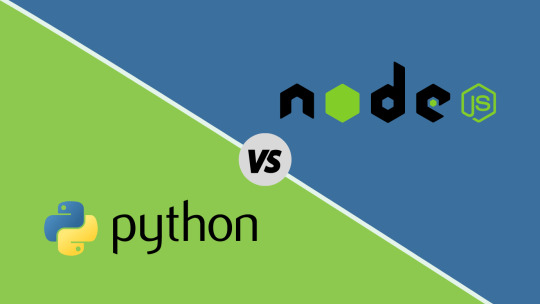
Python vs node js: Which is Right for You?
The high-level difference between Node.js and Python is that the former is mainly used for back-end services, while the latter is often used for front-end development.
In this blog post, we’ll explore common use cases for each language and help you select the right technology for your project.
1. Compatibility
NodeJS is compatible with all the major operating systems and browsers.
Python, on the other hand, is compatible with all major operating systems, but not all browsers.
NodeJS is compatible with all major browsers while Python can only be used in Internet Explorer 8+ & Chrome 17+.
2. Performance
NodeJS vs Python Performance – This is another important factor to consider when choosing the right technology for your project.
NodeJS: NodeJS is dynamically typed, Node.js is essentially a server-side JavaScript framework, which means that it is ideal for writing web applications and APIs. Node.js has been built from the ground up to be asynchronous, event-driven, and non-blocking.
This means that when writing code in Node.js, you have to think about how your application will behave when multiple users are using it at the same time (and more importantly synchronizing their requests). event-driven and single-threaded. So, it’s faster than Python for web development using frameworks like ExpressJS, etc.
NodeJS uses JavaScript on the server side which makes it easy to learn for frontend developers who are new to server-side programming.
Python: Python is slower than NodeJS but it’s a very stable and mature language with great community support. If you want to build a big data application or real-time web application then Python is one of the best options available today because it’s very fast and scalable compared to other programming languages like Ruby, Java, C#, etc.
3. Frameworks
You will find that Python is a library, whereas NodeJS is a framework. The difference between these two terms should be clear by now:
Python is an interpreted language and runs on any platform, whereas NodeJS is a runtime environment that runs JavaScript code in the browser or on servers.
NodeJS has some built-in modules for HTTP requests, but you can always install more modules from npm (Node Package Manager) if needed.
4. Scripting and Web Development
While Python may not be as good at this due to its current limitations in terms of performance on multiple CPUs/cores; however, Python can still handle many concurrent connections without much effort on your part if you use Celery or RabbitMQ.
5. Learning Curve
The learning curve is an important factor to consider when deciding which framework to use. Both Node and Python are general-purpose programming languages, so you can use them for a variety of different applications.
When it comes to Node vs Python Backend, Node is a server-side framework that runs JavaScript on the back end, whereas Python is simply a language that can be used for both frontend and backend development.
Why is NodeJS better than Python? Since NodeJS uses JavaScript as its core programming language (the same as HTML), it is easier to learn than Python.
If you are comparing NodeJS vs Python for web development, then NodeJS will likely be more appealing because there aren’t many things that come with it out of the box like some other frameworks do (like Django).
6. Memory Management, Concurrency, and Database Access.
Memory management: NodeJS uses a V8 JS engine that is faster than Python’s CPython. NodeJS also has better memory management than Python.
Concurrency: NodeJS is designed to support a large number of concurrent connections, making it useful in real-time applications such as chat servers and multiplayer games.
Because of its asynchronous nature, you are not required to use threads or callbacks which makes it easy to code and test your code.
Database access: If you need any database access in your project, then NodeJS is the right choice for this purpose because it comes with an inbuilt database library called “Mongoose” that allows you to interact with MongoDB databases easily without writing much code at all!
7. Supported Platforms and Libraries
Another important factor is the supported platforms and libraries. NodeJS is supported on a wide range of platforms, including Windows, macOS, Linux, and Unix.
Python has similar support but also includes Android and iOS (this is not surprising since Python was initially developed to run on mobile devices).
NodeJS has a much larger community than Python which means there is more opportunity to find help with issues you may encounter.
8. Datasets and Libraries Support Python and Nodejs
Python has a much larger community and ecosystem. This means that there are numerous libraries for various use cases, as well as automation tools for DevOps. Python is also the language of choice for data analysis and machine learning
NodeJs is better at server-side programming, while Python can be used both on the front end and back end
Summing Up…
At the end of the day, both NodeJs and Python are great languages with a lot of advantages. It all comes down to what kind of project you’re working on and whether one is better suited than another for your needs.
The NodeJs vs Python debate has been raging for years, with no sign of slowing down anytime soon. If you’re looking to start a new project or need some help choosing between the two languages, this article will give you some pointers on how they stack up against each other in terms of performance and popularity. And if you need any assistance with building the applications then contact the Digital Info Bytes team to discuss your requirements in detail.
This article is initially published on Digital Info Bytes!
#Node vs Python Backend#Nodejs or Python#Nodejs vs Python#Nodejs vs Python for Web Development#Nodejs vs Python Performance#Why Node JS Is Better Than Python
0 notes
Text
Recruitment Statistics
How much does it cost to hire someone? If you want to get started with recruitment, you might be wondering where to start. There are plenty of resources out there to help you, from job boards to social media platforms. Learn more: https://blog.hirenest.com/20-latest-recruitment-statistics-that-you-should-know/

Recruiting is a time consuming task, especially if you don’t have experience or expertise in recruiting. The good thing is that there are lots of tools available to help you manage the whole process efficiently.
There are various ways to recruit employees. Some companies prefer to go through their existing network, while others choose to advertise their jobs on job boards. Regardless of the method, there are some things you should consider before starting to look for new hires. First, decide what type of candidate you’d like to attract. Are you looking for people who already work at your company? Or do you want to find candidates who would fit into your culture and values? Think about the skills and qualifications needed for the role, and whether you’d prefer to focus on internal or external applicants.
Once you know what kind of person you’re looking for, think about the qualities you’d like them to possess. Do they need to be highly skilled? Have strong communication skills? Be able to work independently? What will motivate them to join your team? You can find out more in our article: https://blog.hirenest.com/20-latest-recruitment-statistics-that-you-should-know/

To answer this question, we first need to understand why people leave their current positions. According to the Bureau of Labor Statistics, around one third of all workers change jobs every year. This means that most people will probably move between different roles throughout their career.
Hiring Statistics
The average salary for a software engineer in 2017 was $110,000 per year according to Glassdoor.com. That number has increased by 16% since 2015. Software engineers typically work 40 hours per week and earn overtime pay if they exceed those hours.
In addition to salary, software developers may receive bonuses based on performance metrics like code quality and bug counts. They may also receive stock options, which allow them to profit from company growth.
If you want to become a developer, it helps to know what languages and frameworks are used most often. For example, JavaScript is the language of web browsers and NodeJS is the server side framework of choice. Python is another popular option because it's easy to learn and powerful enough for many applications.

The average interview lasts between 30 minutes and one hour. Most candidates spend around 20 minutes preparing for the interview before they walk into the room.
Once inside the interview room, it takes an average candidate approximately 15 minutes to prepare for the first question. This includes reading through the job description and researching the company. After this preparation phase, most people take another 10–15 minutes to answer the first question.
Diversity in Hiring
The diversity in hiring statistic comes from a study by the National Bureau of Economic Research (NBER) which found that companies with greater racial and ethnic diversity tend to perform better financially than those without it. This was true across industries and regions, but especially among small businesses.
In fact, the researchers found that “diversity has a positive effect on financial performance, regardless of industry or region.” They concluded that this may be because diverse teams are able to solve problems more quickly and creatively.

Recruiting and Hiring Statistics for HR
The most common reasons people leave jobs include not being challenged enough at work, feeling undervalued, having too many demands placed upon them, and not receiving adequate training or feedback. In addition to salary, job satisfaction is another important factor to consider when choosing a career path. If you don't like what you're doing, it's hard to stay motivated and engaged. A study published in the Journal of Applied Psychology found that employees who were given challenging assignments reported higher levels of job satisfaction than those who weren't. The average cost of hiring someone new is $2,000-$3,000 per year. This includes recruiting costs, interviewing candidates, screening resumes/CVs, conducting reference checks, and onboarding. It doesn't take into consideration the lost productivity from the employee who quit or was fired.
Resume Statistics
The average resume has only three bullet points. In fact, many resumes have just one bullet point. This is because most people don't know what they want to say. They're not sure if it's worth writing down all those things they've done. So they write down the first thing that comes into their head.

What do I mean by bullet points? Bullet points are short sentences that describe something important. For example, "I'm a hard worker" or "I love animals." These are called bullets because they're easy to read. If someone reads them out loud, he'll sound like he's reading from a list.
Remote Work & Contractor Statistics
The most common type of remote work is freelancing. Freelancers typically do not receive health insurance coverage through their employers, so they must pay out of pocket for any medical expenses. In addition, many freelancers find it difficult to build savings because they don’t earn steady income from one month to the next.
The second most common type of remote workers are contractors who work for companies but are not employees. These individuals often enjoy better benefits than freelancers, including access to employer-provided health insurance plans. They may also have access to paid vacation days and sick leave. However, contractors still struggle to save money because they aren’t guaranteed a consistent paycheck each week.The third most common type of remote worker is self-employed. This includes people like consultants, independent contractors, and entrepreneurs. Self-employed workers typically set their own hours and choose which clients to accept. They also don’t receive any benefits from their employers, so they must pay out of pocket for things like healthcare coverage and retirement savings.
While working remotely has its downsides, it does offer some advantages. For example, many remote workers report feeling less stressed at home than they do during the day. Additionally, they tend to feel more productive and creative when they’re away from the office. They also find that they’re able to focus better without distractions around them.
Conclusion
The average recruiter spends about 30% of his time searching for new talent. This includes reading job boards, social media sites, company websites, blogs, etc. In addition, recruiters spend 20-30% of their time sending out resumes and cover letters. They also spend 10-20% of their time interviewing candidates. So, when we add up all those hours spent looking for new talent, we find that recruiters spend about 60% of their time doing recruitment-related activities. If you want to know more about 20 Latest Recruitment Statistics That You Should Know, read this article: https://blog.hirenest.com/20-latest-recruitment-statistics-that-you-should-know/

#hirenest#pre employment assessments#hirenestblog#blog hirenest#bloghirenest#hirenest blog#pre-employment screening tests#pre-employment assessments#recruiting#Hiring Statistics#Recruiting#Recruitment Statistics#Pre-Employment Screening Assessments#Pre-Employment Assessments#Pre-Employment Tests#Pre-Employment Testing
0 notes
Text
0 notes
Text
RT @Khulood_Almani: What's the difference between #BigData & #CloudComputing❓ v/@ingliguori #DataScience #AI #MachineLearning #NLP #Tech #Digital #IoT #Flutter #100DaysOfCode #coding #innovation #python #javascript #Fintech #Marketing #ReactJS #programming #Nodejs #blockchain #Web3 #womenintech https://t.co/vYCc4w2CVq
RT @Khulood_Almani: What's the difference between #BigData & #CloudComputing❓ v/@ingliguori #DataScience #AI #MachineLearning #NLP #Tech #Digital #IoT #Flutter #100DaysOfCode #coding #innovation #python #javascript #Fintech #Marketing #ReactJS #programming #Nodejs #blockchain #Web3 #womenintech https://t.co/vYCc4w2CVq
— Lola Montalban 🧠 🫀🎙️🐝♥️🤍 (@Lomonpla) Apr 23, 2022
via Twitter https://twitter.com/Lomonpla April 23, 2022 at 06:36PM
0 notes